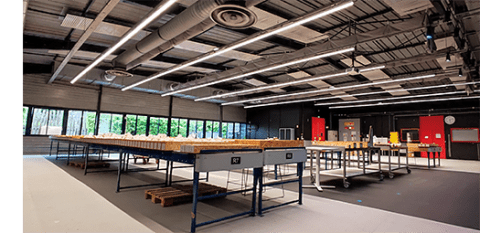09/10/2024 News
The TotalEnergies Corehouse, a true geological encyclopedia
At the Jean Féger Scientific and Technical Center (CSTFJ) in Pau, methodical studies and sampling of the huge collection of rocks from all around the world, contribute to TotalEnergies’ energy transition strategy.
- The corehouse at TotalEnergies on the CSTJF site in Pau is a storage area for the cores sampled during drilling campaigns, and a real library of geological samples that tell the history of the Earth. The rocks hold data crucial to understanding hydrocarbon reservoirs.
- The corehouse enables TotalEnergies’ geologists and engineers to analyze the composition of the subsurface, to evaluate the properties of rocks and characterize hydrocarbon reservoirs. This analysis is essential to the construction of a reservoir model to reduce the risks related the development of O&G projects.
"A core sample is a rock cylinder, taken from the subsurface during drilling campaigns from hydrocarbon exploration and production campaigns. However, the corehouse is much more than a simple technical tool where rocks are sampled and analyzed. It’s one of the symbols of TotalEnergies’ commitment to the innovation and excellence that are omnipresent at the CSTJF", explains Lionel Martinez, Laboratory Manager.
For 30 years, cores from affiliates across the world are received at the CSTJF so that samples can be taken and analyzed. Cores are rock cylinders, usually around 10 centimeters in diameter, sampled in the wells in 9 to 27-meter lengths. In some wells, up to 400 meters of rock have been extracted. They are one of the only tangible elements to confirm the presence of hydrocarbons.
Unique and valuable, expensive to acquire, cores are the only means of ‘touching’ the hydrocarbon reservoir. They provide crucial information on the petrophysical, geochemical and mineralogical characteristics of the rocks, which are required for reservoirs understanding.

An average of more than 1,000 meters of cores each year are added to the historical stock at TotalEnergies. Depending on the core type, our specialists propose customized technological solutions using a range of high-tech apparatus and equipment. The aim is to produce the best possible rock characterization and extract valuable information from the cores.
"Core studies are one of the specialties in Pau. The corehouse follows a standardized procedure for routine analyses, but also provides innovative, customized solutions, suited to requirements or each rock type. This shows just how flexible and innovative the laboratory can be" affirms Olivier Ridet, responsible for scanner image acquisitions. "For example, we participate in research on CO₂ capture and storage technologies, which are essential for reducing greenhouse gas emissions and for boosting the transition toward cleaner energies."
Though the central activity at the corehouse is still oil and gas exploration, the technical competencies are now being applied to other sectors. Cores, as corporate heritage, are a reference and resource for geological and geophysical studies, and help TotalEnergies make informed decisions in CO₂ storage activities.
The 10 laboratories at the CSTJF, originally created to meet the needs of the Exploration & Production branch, develop competencies that today help them to provide solutions to the new environmental challenges TotalEnergies faces.
To learn more about the labs:

